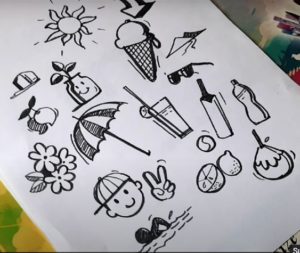Chapter 4: Keep Calm and Act On
4.1. What are the forms of dramatisation?
Theatre-based strategies have long being using to facilitate learning. Dramatisation includes all activities where learners act out, represent, or bring a text, idea, or event to life. There are many ways to incorporate dramatisation into education, but some of the most popular and easy-to-implement techniques are: monologues, dialogues, and narration.
Monologues
A monologue is a long speech spoken by one character. It often shows their private thoughts or feelings, almost like they are talking to themselves. Monologues are a powerful way to show a character’s emotions, reasons, or point of view.
Watch as Osama Romoh performs a short monologue (Youtube CC Licence) in which the word ‘no’ is said in a range of emotions.
Here is a video of Orlando’s opening monologue from William Shakespeare’s play As you like it (Youtube CC Licence).
Dialogues
A dialogue involves spoken exchanges between two or more characters. It brings stories to life through interaction and helps portray relationships and conflicts. Dialogues are effective in role plays and simulations. Listen to a dialogue titled ‘Work.
Narration
A narration recounts a story, often interspersed with dialogues or monologues to give context and depth to the characters’ experiences. The narrator provides a guiding voice that helps the audience follow the storyline. Listen to a story titled ‘Mangoes’.
Tableaux
A tableau is a frozen picture where learners use their bodies to “freeze” into a scene . Learners stand still, without words, to represent an idea, a situation , or a feeling. It is often used as a starting point before acting out a full scene, or as a quick way to capture and reflect on ideas. They are quick to set up, need no materials, and can spark deep conversations.
According to Jessica Del Vecchio, tableaux work well across subjects: literature, history, social studies, even science (to represent systems or processes). To read Vecchio account of the use of activities inspired by Augusto Boal’s Image Theatre, click here. By using these forms of dramatisation, you can bring classroom content to life, helping learners experience concepts emotionally and intellectually.
Activity: Bring objects to life through dramatisation
- Look closely at the doodle and pick one object that captures your attention.
-

Summer Time by Kaumudi Sahasrabuddhe, CC BY NC
-
- Imagine that you are this object, but with thoughts and feelings. Consider a typical day in your life as this object. What would you be experiencing? How do you feel at a particular moment during the day?
- Express yourself in words:
- Complete the sentence: I am the (name of the object) and (describe your feeling and situation). For instance: I am the parasol, and I am currently in a closet, feeling lonely, but I long to meet my bestie, the sun!
- Build on: Add a backstory for the object, an autobiography or just more context, like the rationale for it’s the emotional state
- Reflect: Why do you think the object felt the way it did? What situation(s) would change what the objects’ emotional state? How did it feel to step into the role of an inanimate object? What emotions did you discover while imagining the object’s perspective?
This activity helps you practice dramatisation by giving voice to everyday objects, fostering empathy, creativity, and critical thinking.
Media Attributions
- Summer Time © Kaumudi Sahasrabuddhe is licensed under a CC BY-NC (Attribution NonCommercial) license


